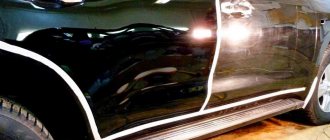Lada Largus is a high-capacity station wagon passenger car developed jointly by Renault-Nissan and AvtoVAZ.
In Latin, the word largus means "generous." AvtoVAZ says that this word became the basis for the name of the new model. The owners also believe that largus is consonant with the English large (large) and the Spanish largo (long) - this, however, is also not far from the truth!
The Lada Largus station wagon is a licensed copy of the Dacia Logan MCV. The model was developed jointly with the Renaul-Nissan concern. Car enthusiasts are offered several options: a five- and seven-seater station wagon, as well as a van with an all-metal body and two seats for a driver and a passenger.
Lada Largus is not much different from Dacia Logan MPV. The basic package includes ABS, air conditioning, audio system, airbags. The car is offered to buyers with a manual transmission. An automatic transmission is not yet available, but an all-wheel drive version is planned.
The car interior is spacious and functional. The seats fold in a variety of ways. The exterior is simple but attractive: strict lines, rectangular shapes, wide moldings on the sides. The model was conceived as a utilitarian car for commercial purposes and transportation of large items, and the developers managed to fully realize all their ideas.
History of the creation of Lada Largus
Lada Largus was first introduced to customers in 2010. Mass production began in the spring of 2012, and the car went on sale in July. More than seventy percent of the components for the new model are produced in our country. This has become one of the reasons for the popularity of the car, since the presence of domestic parts makes it affordable both for purchase and maintenance.
According to surveys, Lada Largus is one of the best models offered by AvtoVAZ since the 80s, and the first car that can be called relevant without exaggeration. All equipment meets modern European standards. Based on the road realities of our country, the design of the suspension arms and front brake mechanisms have been strengthened.
Processing Features
Experts strongly recommend that Lada Largus undergo anti-corrosion treatment at branded dealerships. The problem is that various anti-corrosion compounds can react with each other, resulting in complete destruction of the protective coating. Official VAZ dealers for the most part use products recommended by the manufacturer, so problems should not arise. You can also purchase one can of a special composition at the dealership in order to study its composition and in the future buy a cheaper analogue.
Since professional anti-corrosion treatment costs a lot of money, you can do the job yourself. This will require a liquid protective composition, as well as a thick mastic with high fluidity that can fill the seams. Tools include a pneumatic sprayer with a flexible nozzle for getting into cavities, as well as a brush, several rags, screwdrivers and wrenches for dismantling various parts. During basic anti-corrosion treatment of the Lada Largus, the composition is applied only to the bottom, and special attention should be paid to the following areas:
- Under the muffler and exhaust pipe;
- Behind the front bumper;
- At the bottom of the thresholds;
- Under the wheel arch linings;
- Welded seams on the bottom;
- Spare wheel niche under the trunk.
If you want to improve the anti-corrosion treatment, you will need to completely dismantle the interior trim, and then treat welds, cavities and other potentially dangerous parts with a thick mastic.
Technical features of Lada Largus
The car can be purchased with one of two 1.6-liter engines with 87 and 105 hp. (both engines are from Renault Logan). One of the engines is eight-valve, the second has two camshafts and sixteen valves. The Renaul Logan platform on which the car is produced was developed as a budget one, and its capabilities have already been repeatedly tested in practice. What matters for car owners is that the engines have already shown their best performance in practical use.
The car is equipped with a simple and reliable five-speed gearbox assembled from French parts. Springs and shock absorbers are specially selected taking into account the load capacity and poor quality of roads.
The Lada Largus design uses a front subframe. The engine is installed on it, and it also serves as a mounting location for the power steering rack. The rear suspension uses a torsion beam, allowing separate configuration of the spring and shock absorber. This design makes it possible to increase the distance between the arches of the rear wheels, which makes it possible to make the volume of the luggage compartment as large as possible, and its bottom flat, since there are no “cups” of racks at the rear, which take up space in the trunks of cars with independent suspension.
The shape and type of body provide a large volume of not only the trunk, but also the interior. The car is offered to buyers in cargo-passenger and passenger configurations, designed to carry 5 or 7 passengers. Even if you are tall, you can sit comfortably in the second row and not rest against the back of the driver’s seat. Thanks to the high roof and square opening, you can easily get to the third row without bending over. The third row can comfortably accommodate two people 180 cm tall.
The trunk is striking in its size; in a seven-seater car it is smaller if the third row seats are not folded. In addition, the rear doors have special latches with which you can change the angle of their opening: they can be opened fully or halfway. This adjustment is of no small importance when loading large cargo.
Our new test drive Lada Largus
Initially, I planned to drive through this place without any detours. But reality made its own adjustments. We got in long before the epicenter. We somehow crawled to the gas station. Snack, toilet and thinking about future plans.
We vomited several kilometers to the gas station. Good people there suggested that there was a detour. We'll leave at the end of the traffic jam. The detour turned out to be simple. Along the highway, right after the gas station there is an intersection. We took it to the left and drove along a narrow road through a corn field. Eight kilometers awaited us along a terribly dusty intersection on new ball and steering wheels. “Across the fields, across the fields, gray Largus rides on his own,” I sang a song from my daughter’s cartoon. I don’t know how it was in the back seat, but there were no negative comments about the driver or the car. No dust got into the interior at all. Thanks to the seal on the doors. As a reminder of the Voronezh roads, there were small scratches on the left side.
Judging by the scale of road work in the Pavlovsk region, a full-fledged highway will soon bypass the village. There will be one less bottleneck.
So, Losevo is passed. We are looking for a place to stay for the night. A suitable place turned out to be 72 km away in the area of the Osetrovsky bridgehead. Here is the Lukoilovskaya gas station with a huge parking lot. The main thing is not to overshoot the turn. There's no going back, there are bricks everywhere. The coordinates of the place are 50.097681, 40.432383.
Overnight in Largus
The car can easily accommodate two adults and a child for the night, but without any pretensions to comfort. With my height of 182 cm, I lie at my full height. This means the rest of the household will also fit in.
We move all things forward - to the front seats and under the dashboard in front of them. Such a large pile of things grows, almost to the ceiling. These include a baby seat, a stroller and large bags. Low bags go where the legs of the rear passengers were, while the rear seats fold completely. The sleeping place is ready.
The only and big drawback when spending the night in Largus is the uneven floor. After folding the second row seats, a decent hollow is formed, which needs to be covered with something. Otherwise it is impossible to sleep. To level it, you have to add existing blankets and pillows.
To solve this problem, enthusiasts make a so-called “flat floor”. A ready-made one costs about 4 thousand rubles. and is a plywood structure, which, after unfolding, forms a surface that is flush with the trunk floor. The only negative is the fairly decent weight. But the solution is great. If you wish, you can make it yourself.
The next morning we move on. The sun is getting hotter, the car is getting warmer. Tinted windows significantly add heat to the cabin. We don’t use air conditioning because it’s simply not standard in the package. Yes, even if there was, I still wouldn’t turn it on.
Curtains made of white pillowcases simply help out from direct sun.
Rostov-on-Don and Kuban
It’s impossible to drive through Rostov quickly during the day. This is the second place where you can stand for a while. The traffic jam begins in the area of Grushevsky rise. But still not deaf and after about an hour she is left behind. Ahead is the Krasnodar Territory.
After some time, Kuban meets us. I finally manage to photograph the “Welcome” sign.
There are no traffic jams, the road is good. By evening we plan to get to the sea.
Villages
After a few kilometers the large Kuban villages begin. The first of them is Kushchevskaya. Then Kislyakovskaya, towards which we go from the M4 to the right. Next on the way are Leningradskaya (here you can buy fruit) and Kanevskaya.
Bypass Timashevsk
In order to get around the famous traffic jam in Timashevsk (difficult place No. 3), after Kanevskaya we go through the village of Bryukhovetskaya. I spotted this route on one of the forums. Worked great.
So, the first key point is a fork in the road. We're going straight on it. First we pass the village of Pereyaslavskaya. Then there will be Bryukhovetskaya. You can drive along the main street, or you can immediately turn right onto Tolstoy Street and drive to the end. That's how I drove. Then turn left onto Komsomolskaya and then straight ahead. The village is left behind.
The road is good, if not excellent. In my opinion, pits are nonsense for them. There are practically no cars. Only occasionally do local trotters overtake. After about 25 km there will be an exit to a new road. We go to the right. Then continue straight ahead until you turn right to the village of Rogovskaya.
After Rogovskaya there will be a fork. The main road turns right. There is a sign: Greeks 8 km. Let's turn. Ahead is Grechanaya Balka and three 90-degree turns.
The next point is a right turn to the village of Novonikolaevskaya. It is 12 km away. We pass Novonikolaevskaya, then Starodzherlievskaya. Ahead is the village of Poltavskaya. You can refuel here. Assorted gas stations.
Slavyansk-on-Kuban is ahead. This is where the detour ends. This route extends the direct route through Timashevsk by only 16 km. But the benefits are obvious. I didn’t have to stand in an eternal traffic jam in Timashevsk.
Of course I know about bypassing the traffic jam through Timashevsk itself. But this is not a 100% option. But I tried the above method for the first time and I liked it. Next time only for him.
So? How's Largus?
Based on the results of three trips to the sea, I give Largus a solid four. Even such a weak engine by modern standards more than coped with the tasks assigned to it. But some extra power wouldn't hurt. It is worth noting that after a long drive on the highway at high speeds, the engine changed for the better and it was more pleasant to drive. In traffic jams the engine never overheated; the temperature scale always showed four divisions.
Of course, some things are greatly lacking, for example, sound insulation and more comfortable seats in the front and rear.
Some numbers
I was pleased with the gas mileage. In total, about 4000 km were covered. 11,800 rubles were spent. According to my calculations, the consumption was approximately 8 l/100 km. The average cost of gasoline along the entire route is 42.5 rubles.
That's all. Have a good holiday everyone!
Other autotrips
OverviewPrices and specificationsCharacteristicsPhotoVideo
The Lada Largus station wagon is equipped with 1.6 liter engines. Buyers are offered versions with a five-seat and seven-seat interior.
Lada Largus 1.6 (87 hp)
Prices for the five-seater Lada Largus, equipped with an eight-valve engine with an output of 87 hp. s., start at 564,900 rubles.
Interesting facts about Lada Largus
Prime Minister V.V. took part in the launch of mass production of the Lada Largus car. Putin. The head of government talked with workers and got acquainted with the production. When the first production car with number 000001 rolled out of the container, Putin, together with representatives of Renault, Nissan and AvtoVAZ, signed the hood of the car.
The warranty for Largus is 36 months or 100 thousand kilometers. AvtoVAZ has established an extended warranty period for individual fast-wearing parts: shock absorbers - 24 months or 30,000 km, batteries - 24 months or 60,000 km, and so on.
Lada Largus is not all galvanized, but only some body elements
The following two tabs change content below.
- About the expert:
Frets Expert
An expert on Lada cars with many years of experience. I own a Lada Granta car, I collect cramps based on the Priora. Sometimes I stay overnight in the garage. My wife is more jealous of cars than of women.
All possibilities for applying galvanization at AvtoVAZ come down to two: buy galvanized steel or apply zinc using the “cold” method. In the second case, the coating is applied from a spray bottle. The galvanic method is not used at AvtoVAZ, and even more so, the enterprise does not have baths with molten zinc.
All Largus family cars have the following parts galvanized on both sides:
- front wings,
- roof,
- external door panels,
- hood.
Proof of the galvanization of these body parts by the factory is shown in the photo.
The roof, or rather, many roofs
Left rear door (outer panel)
Doors for station wagon body
Are the thresholds galvanized?
The thresholds are also galvanized on the outside, and each seam remaining after welding is treated in the same way. Although the bottom is not galvanized, it is treated with a primer. And it, in turn, is applied using the galvanic method.
Advantages and disadvantages of Lada Largus
The main advantage of the Lada Largus is practicality and spaciousness. Proper placement of seats ensures comfort for the driver and front passenger. The dashboard is easy to use, the instrument cluster is easy to read. The tailgates are equipped with pockets for small items.
Among the shortcomings are poor sound insulation, the location of the spare tire under the bottom, which reduces ground clearance, a limited set of functions as standard - no ABC, no front electric windows. The signal button is located “in the French style” on the steering column lever, which is unusual for Russian drivers. The view from the driver's seat is slightly impaired by the right front pillar, which covers part of the exterior mirror.
Foreign media call Lada Largus the new flagship of AvtoVAZ. It took about four years to achieve such success. During this time, the company was able to modernize even production to meet the needs of Russian-assembled foreign cars. Today, the level of localization of auto components has been increased to 50%, and in the future this figure is planned to be increased to 80%.
volume, models, characteristics and reviews
The Largus car model presented today by the LADA concern is a joint project of the domestic automobile industry and the French corporation Renault. This car model has been produced since 2008. In many characteristics, Largus copies the Renault Logan MCV model (production began in 2006), having only the radiator grilles, parts of the cladding and, in fact, the manufacturer’s logo that are distinctive.
External characteristics
The vehicle's configuration largely determines which engine the Largus will have, but regardless of this, the external dimensions of the vehicle will remain standard.
Judging by them, we can safely classify the car as the largest among the B-class:
- ground clearance – 16 cm;
- base – 2 meters and 90.5 cm;
- length – 4 meters and 47.3 cm;
- width – 1 meter and 74 cm;
- height without handrails – 1 meter and 64 cm (with handrails 3.4 cm higher).
With standard dimensions, you can purchase a car in the modifications of a cargo van or a passenger car. The latter, in turn, can also be 5-seater or 7-seater. Depending on the selected modification, the volume of the luggage compartment will differ. Thus, cargo vehicles have only 2 seats for passengers and a cargo compartment volume of 2540 liters. The modification for 7 passengers will accommodate only 198 liters of luggage, and the 5-seater version will accommodate 700 liters. If you further fold the rear row seats, you can increase this volume to 2350 liters, which is almost the same as the cargo version.
In general, the car's appearance is discreet, and its main advantage is its spaciousness. Maybe that’s why its name is translated from Latin as “generous.” For the convenience of using a large volume of luggage compartments, they are equipped with hinged doors. The total glazing area of the car is large, all the lines are straight, the shapes are simple rectangular.
Interior features
Depending on the configuration, not only Largus engines can change. The most equipped offer for the car has the ability to adjust lumbar support, power steering, front electric windows, air conditioning, ABS and a radio. As standard, the cabin features a seat lift, a vertically adjustable steering wheel and an easy-to-read front panel, which is a noticeable difference compared to the Logan MCV.
There is a lot of space in the cabin, and the rear seats can comfortably accommodate passengers of any height and weight. If necessary, the seats can be removed or folded. The car interior is also equipped with side and front airbags, three-point belts and an Isofix child seat mounting system. Passive safety of passengers is ensured by a special body design that allows the impact to be redistributed thanks to the front subframe.
Main operating parts
In general, Largus engines have minor differences in reliability and type of fuel used (gasoline only). Their volume is always 1.6 liters and operates only in conjunction with a five-speed manual transmission. Due to Euro-4 requirements, the Largus engines had to be revised at one time, and they lost a little power. Now the 8-valve power unit has only 83 hp. s., and 16-valve – 103 l. With. The difference in their performance is noticeable in the acceleration time to 100 km/h, maximum speed and other dynamic indicators. So, the engine has a capacity of 83 hp. With. capable of accelerating to 100 km/h in 14.5 seconds and maintaining a top speed of 156 km/h. Another modification of the power unit is already capable of demonstrating similar acceleration in just 13.1 seconds, and its top speed is at around 165 km/h.
The Largus got its chassis, front suspension and rear beam from its predecessor, the Renault-Dacia Logan MCV. Of course, they were strengthened for stable operation in our climate and bad road conditions. When buying a car, you should pay attention to the turning angle of 11.5 meters.
General characteristics of Largus engines
Despite the fact that the power units for this car were completely developed by the French concern, the engines are fully adapted to the conditions of the Russian climate. Each of them, regardless of modification, can be used in harsh winter conditions, off-road conditions and even sharp temperature fluctuations, which is typical in some regions.
Regardless of the valve system of the Largus engine, during the first change the oil should be filled only with what is indicated as standard. At different times the company changed oil manufacturers, so special attention should be paid to this issue.
It is interesting that engine manufacturers set a service life of only 160 thousand kilometers on them, despite the fact that completely different indicators are indicated in the passports for power units upon purchase.
Eight valve engine
This modification of the power unit was at one time borrowed from the Logan and Sandero car models. For the first time, these engines began to be installed on foreign-made cars 7 years ago, but after the need to comply with Euro-4 environmental standards, their design had to be revised, which led to a slight loss of power.
According to the manufacturers, the resource of this unit is 400 thousand kilometers. The 8-valve Lada Largus engine receives positive reviews from consumers not only for its good service life. An important condition for many is the unit’s unpretentiousness to fuel. Of course, regular use of low-quality gasoline will affect the performance of the car, but several refills with low-octane fuel will not harm.
Disadvantages of the unit
According to motorists, the main disadvantages in the operation of this engine can be identified:
- high fuel consumption;
- high noise level;
- noticeable vibrations during operation;
- floating idle speed;
- the need to adjust the valves every 30 thousand mileage;
- the need to replace the timing belt every 60 thousand mileage;
- frequency of crankshaft oil seal leaks.
Drivers also note that the power of this engine is not always enough, especially at the beginning of the journey and in the yards.
16-valve modification
The engine in the Largus K4M is installed only on a 7-seater station wagon and in luxury car trim levels. Its main distinguishing features are: quiet operation, absence of vibrations and fuel consumption in mixed mode of only 9 liters per 100 km.
Disadvantages of the unit
16-valve Largus engines also do not always have only good reviews. Among the disadvantages of the power unit, many note insufficient dynamics and speed skipping when using low-octane fuel. Of course, the complexity of assembling this unit also affects its cost.
The price for its maintenance will also be noticeably higher (compared to an 8-valve engine), but the manufacturer provides a guarantee of 450 thousand kilometers, and with proper care and timely inspection, the engine will last longer.
In general, if you choose between two engine models, the more powerful one is also more profitable, since it does not require frequent valve adjustments.
Which engine is better?
The undoubted conclusion from many opinions is that when choosing an engine for Largus, you should pay attention to its most powerful model. Only the 16-valve unit can boast of maximum reliability and practicality, since it performs equally well in both highway and city conditions.
Today, Largus models with a VAZ and Spanish engine are produced. You can determine the place of their assembly by the markings on the power unit: those assembled in Russia - P, assembled in Spain - D. Interestingly, these engines do not differ at all in quality. Perhaps this was due to the replacement of the production line, which now meets all international standards. In general, standard jokes about the domestic auto industry will be inappropriate in this case.
The only nuance of using a car with a powerful engine installed is its operation in the summer, when the air conditioning is turned on in the cabin. Low speeds of the power unit are felt with some effort, but at speeds above 90 km/h this ceases to be felt.
Fundamental differences between engines
AvtoVAZ began the tradition of producing the same car model with the opportunity to purchase it with different internal combustion engines with the production of the tenth Lada model. It’s interesting, but the “head” of the power unit there could even be replaced independently. Today, various modifications of cars are offered to consumers in the form of Largus.
Thanks to simple mathematics, you can determine that in the simplest engine model there are 4 cylinders, each of which has 2 valves. This feature negatively affects gas exchange and the intake and exhaust tract system, which means it reduces the vehicle’s efficiency and increases fuel consumption.
In fact, thanks to the painstaking work of engineers, it was possible to reduce the gap between fuel consumption in different engine modifications to almost zero. Thus, technical characteristics are not significant factors of choice, but the cost of power units with different numbers of valves still differs noticeably.
The newer Largus Cross model has only a 16-valve engine. This is explained by the car’s approach to the luxury class. In its standard configuration, in addition to a powerful engine, there are other advantages that are available in regular models only with an additional payment or a high-comfort package.
In any case, it should be remembered that absolutely all Largus car models are assembled on modern assembly lines and meet all international standards. Does it make sense to pay more for the number of valves with practically similar characteristics - this, of course, is a personal matter for each car enthusiast.
fb.ru
Advantages of Lada Largus
This model, without a doubt, has a number of advantages over other Lada cars. Largus is fundamentally different from other models in the VAZ line. Borrowed from the West, the B0 platform is excellent for transporting cargo and a large number of passengers - 7 passenger seats and a fairly large compartment for transporting cargo with the seats folded. In addition, the car is available in a 2-seater “Van” version, which is perfect for the business sector. The car's carrying capacity ranges from 500 to 700 kg, depending on the body type, which is a very good result for such a compact car. At the same time, the fuel consumption parameter will certainly please the owners of this model - only 8 liters per 100 km in the combined cycle. The car also borrows from Dacia such advantages as an excellent interior and exterior.
Lada Largus for business (van)
This model has caused particular demand among entrepreneurs. A roomy, voluminous, load-carrying vehicle with low fuel consumption at an affordable price - this cannot but be an advantage for small and medium-sized businesses. It was this category of carrying capacity that was so lacking among domestic cars. The well-known Gazelles are operated half-loaded most of the time, and half of the Gazelle’s carrying capacity is exactly the full load of a Lada Largus van - so why overpay for moving an extra pile of metal.
Among other things, the reliability of Lada Largus surpasses all other commercial vehicles produced under domestic brands. This is due to the fact that the European analogue, which has long established itself as a reliable car, is taken as a basis.
What other body types does Lada Largus have?
There is a subsidiary company in Nizhny Novgorod that is engaged in the conversion of Lada Largus. In total, there are more than 20 variations of Lada Largus bodies, which are designed for different purposes. Most of these cars are intended for government agencies.
At the moment, production is focused on two lines: LADA ROOF and LADA KUB.
LADA ROOF is a standard Lada Largus based on a station wagon, van or Cross, but with an enlarged roof - from 280 to 320 mm.
Thanks to this modification, the luggage compartment volume of the van was increased from 2450 liters to 3.5 cubic meters.
LADA KUB is a more global remake of Largus. In addition to increasing the roof, the rear overhang of the body increases by 37 cm.
Thus, the cargo volume increases to 4.2 cubic meters, and if you throw out the partition between the trunk, you can even get 4.6 cubic meters for transporting cargo.
7-seater Lada Largus station wagon
The 7-seater version of the Lada Largus differs from the 5-seater by the presence of a 3-row seat, as AvtoVAZ marketers call them - places for kissing. An ordinary station wagon can be converted into a 7-seater version only by installing an additional row of seats, as well as minor modifications to plastic parts and the installation of third-row seat belts.
In other words, there is no difference in the bodies of the 5th and 7th seat versions of the Lada Largus. The only difference is in additional equipment and finishing.
Development of the Lada Largus family
For the first time in Russia, the model was presented at the Moscow Motor Show in 2010, under the name Project R90. The first Largus rolled off the AVTOVAZ assembly line a year later, in the summer of 2011.
In February 2015, the official start of sales of Lada Largus Cross was announced. The main feature of this version is increased ground clearance by 25 mm and, as a result, improved cross-country ability. The high stance of the car is emphasized by protective plastic linings on the front and rear bumpers, wheel arches and sills, unpainted bumpers, black door frames, alloy wheels with a diameter of 16 inches with oversized tires.
On April 4, 2021, sales of the new dual-fuel LADA Largus CNG model were launched. This version of the car can use gasoline and methane as fuel. When fully refueled, LADA Largus CNG has a power reserve of more than 1,000 km. The use of methane allows reducing fuel costs by three times (advantages of Largus CNG).
In July 2021, AVTOVAZ presented the updated Lada Largus family. LADA has updated the popular Largus station wagon, bringing its exterior in line with the corporate style of the Brand. Along with the style updates to the car, there have also been functional changes that increase comfort and safety (which has changed).
In October 2021, AVTOVAZ announced the start of sales of LADA Largus #CLUB. This is a special package, based on the Comfort version, but with elements of the top Luxe versions. At the same time, additional equipment in the limited edition is offered at a particularly favorable price (#Club review).
In July 2021, AVTOVAZ introduced the Largus Cross Quest. The car in the special Quest version received new ergonomic front seats, improved sound insulation, original wheels, glossy black exterior mirror housings, and nameplates indicating the name of the special series of the model.
Currently, AVTOVAZ is preparing a restyling of the Lada Largus. An experimental batch of these cars has already been seen on the streets of Togliatti. Serial production can begin after a corporate holiday, i.e. after August 16, 2021.
Keywords: Lada Largus Cross | Lada Largus cng | lada largus cross quest | #CLUB
-2
Share on social networks:
Found an error? Select it and press Ctrl+Enter..
Options and prices for Lada Largus
The most inexpensive option would be the Lada Largus Van, the cost of which will be 460,000 rubles. ABS and EBD systems, as well as a driver airbag, will be available in this configuration. The comfort package for 555,000 rubles will add air conditioning, power steering, heated seats, power windows, a passenger airbag and other nice little things to the car.
The top-end option with the best characteristics is the Lada Largus Cross for 690,000 rubles. In addition to the advantages of the “Van” model listed above, you will receive mounts for child seats, a leather steering wheel, orange inserts in the interior, parking sensors, a good multimedia system, heated and electrically adjustable mirrors, as well as 16-size wheels with tires from Continental.
The cost of the Station Wagon version ranges from 520,000 to 665,000 depending on the options provided.
The appearance of the Lada Largus model
Serial production of Lada Largus began in 2012 on a new assembly line called B0 - this was the very first joint project of the Renault-Nissan concern and the domestic AvtoVAZ. A year before, test models were released for testing and possible modernization.
The roots of the car, as mentioned above, lie in the French development of 2006 - this car turned out to be very successful, which also played a role in the decision to release a copy under the Lada brand. Of course, the car did not become a complete copy of Dacia - it underwent significant modifications in order to best meet the needs of domestic car enthusiasts.
After the last wave of mistrust, the demand for Lada Largus began to grow exponentially, which often led to the fact that there were simply not enough cars in car dealerships.











